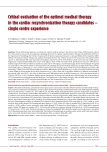Diagnostic algorithm of syncope: integrative approach
Authors:
J. Plášek 1; V. Doupal 2; J. Václavík 2; N. Petejová 1; Arnošt Martínek 1; M. Táborský 2
Authors‘ workplace:
Interní klinika Lékařské fakulty Ostravské Univerzity a FN Ostrava, přednosta doc. MUDr. Arnošt Martínek, CSc.
1; I. interní kardiologická klinika Lékařské fakulty UP a FN Olomouc, přednosta doc. MUDr. Miloš Táborský, CSc., FESC, MBA
2
Published in:
Vnitř Lék 2011; 57(10): 826-833
Category:
Reviews
Overview
Syncope is a symptom, defined as transient loss of consciousness and postural tone with spontaneous and mostly prompt recovery. At first it is necessary to differentiate other non-syncopal transient loss of consciousness and simple falls, where thorough history taking is pivotal. EGSYS and OESIL risk scores seem to be contributional in initial risk stratification, however they are neither widely accepted nor a part of national guidelines. They are part of the European society of cardiology guidelines, though. Next it is essential expert ECG evaluation, thorough physical status examination, supine and standing blood pressure measurement and carotid sinus massage, if not contraindicated. Successively one has to decide if hospitalization or outpatient management is more suitable. Recently it has been shown, that so-called syncope management units (aimed for short-term hospitalization or fast outpatient examination, including vital function monitoring, echocardiography and facile cathlab access) are effective in fast syncope evaluation. Echocardiography, ECG monitoring and head-up tilt test should be a part of complex diagnostic evaluation. If syncope is not clarified by upon stated methods moreover syncope is recurrent, electrophysiological study, ILR implantation or both are justified. Despite of entire health practitioner’s effort, more than 1/3 of syncopes remain unexplained.
Key words:
syncope – EGSYS/OESIL – head-up tilt test – ILR (implantable loop recorder)
Sources
1. Task Force for the Diagnosis and Management of Syncope; European Society of Cardiology (ESC); European Heart Rhythm Association (EHRA); Heart Failure Association (HFA); Heart Rhythm Society (HRS). Moya A, Sutton R, Ammirati F et al. Guidelines on diagnosis and management of syncope (version 2009). Eur Heart J 2009; 30: 2631–2671.
2. Kautzner J. Synkopa: diagnostika a léčba. Cor Vasa 2007; 49 (Suppl): 63–73.
3. Kapoor WN. Evaluation and outcome of patients with syncope. Medicine 1990; 69: 160–175.
4. Soteriades ES, Evans JC, Larson MG et al. Incidence and prognosis of syncope. N Engl J Med 2002; 347: 878–885.
5. Kenny RA, Kapoor WN. Epidemiology and social costs. In: Benditt D, Blanc JJ et al (eds). The Evaluation and Treatment of Syncope. Elmsford, NY: Futura 2003: 23–27.
6. Campbell AJ, Reinken J, Allan BC et al. Falls in old age: A study of frequency and related clinical factors. Age and Ageing 1981; 10: 264–270.
7. Rose MS, Koshman ML, Spreng S et al. The relationship between health-related quality of life and frequency of spells in patients with syncope. J Clin Epidemiol 2000; 53: 1209–1216.
8. Colivicchi F, Ammirati F, Melina D et al. OESIL (Osservatorio Epidemiologico sulla Sincope nel Lazio) Study Investigators. Development and prospective validation of risk stratification system for patients with syncope in the emergency department: the OESIL risk score. Eur Heart J 2003; 24: 811–819.
9. Quinn JV, Stiell IG, McDermott DA et al. Derivation of the San Francisco Syncope Rule to predict patients with short-term serious outcomes. Ann Emerg Med 2004; 43: 224–232.
10. Del Rosso A, Ungar A, Maggi R et al. Clinical predictors of cardiac syncope at initial evaluation in patients referred urgently to a general hospital: the EGSYS score. Heart 2008; 94: 1620–1626.
11. Plasek J, Doupal V, Fürstova J et al. The EGSYS and OESIL risk scores for classification of cardiac etiology of syncope: comparison, revaluation, and clinical implications. Biomed Pap Med Fac Univ Palacky Olomouc Czech Repub 2010; 154: 169–173.
12. Shen WK, Decker WW, Smars PA et al. Syncope Evaluation in the Emergency Department Study (SEEDS): A multidisciplinary approach to syncope management. Circulation 2004; 110: 3636–3645.
13. Brignole M, Disertoni M, Menozzi C et al. Evaluation of Guidelines in Syncope Study (EGSYS) group. Management of syncope referred urgently to general hospitals with and without syncope units. Europace 2003; 5: 293–298.
14. Parry SW, Frearson R, Steen N et al. Evidence-based algorithms and the management of falls and syncope presenting to acute medical services. Clin Med 2008; 8: 157–162.
15. Krahn AD, Klein GJ, Yee R et al. Randomized Assessment of Syncope Trial: Conventional diagnostic testing versus a prolonged monitoring strategy. Circulation 2001; 104: 46–51.
16. Moya A, Brignole M, Menozzi C. Mechanism of syncope in patient with isolated syncope and in patients with tilt-positive syncope. Circulation 2001; 104: 1261–1267.
17. Menozzi C, Brignole M, Garcia-Civera R et al. Mechanism of syncope in patients with heart disease and negative electrophysiologic test. Circulation 2002; 105: 2741–2745.
18. Brignole M, Menozzi C, Moya A et al. International Study on Syncope of Uncertain Etiology (ISSUE) Investigators. Mechanism of syncope in patients with bundle branch block and negative electrophysiological test. Circulation 2001; 104: 2045–2050.
19. Plasek J, Doupal V, Hrabovská Z. Polohový test – víme o něm opravdu všechno? Vnitř Lék 2009; 55: 955–960.
20. Ruiz GA, Scaglione J, González-Zuelgaray J. Reproducibility of head-up tilt test in patients with syncope. Clin Cardiol 1996; 19: 215–220.
21. Omar AR, Ng KS, Ng WL et al. Reproducibility of tilt-table test result in patients with malignant neurocardiogenic syncope. Intern Med J 2004; 34: 504–506.
22. Linzer M, Yang EH, Estes NA 3rd et al. Diagnosing syncope. Part 2: Unexplained syncope. Clinical Efficacy Assessment Project of the American College of Physicians. Ann Intern Med 1997; 127: 76–86.
23. Hradec J, Berka L, Táborský M. Posuzování způsobilosti kardiologických nemocných k řízení motorových vozidel. Cor Vasa 2006; 48: K47–K51.
Labels
Diabetology Endocrinology Internal medicineArticle was published in
Internal Medicine

2011 Issue 10
Most read in this issue
- Normal pulmonary circulation pressure values in healthy subjects at rest and during exercise
- Treatment of acute exacerbation of the obstructive pulmonary disease with hospitalization at an Intensive Care Unit.
- Resynchronization therapy for heart failure – still many question marks
- Prognostic markers in chronic lymphocytic leukemia
